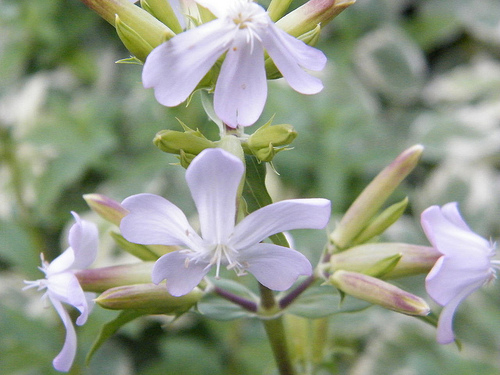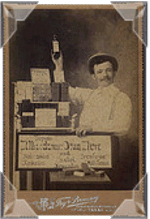CLICK: Color Control Color Choice

SOAPWORT FOLK NAMES
Soapwort was used as a laundry powder/cleaner in pioneer days. It actually creates a cleansing soap and when the ladies were washing the clothes they would go break a branch of soapwort to use to clean the clothing. The Pennsylvania Dutch used the lather to give beer a foaming head, and it is still commercially in use.
Everywhere Betty camped she left an abundance of new soapwort plants. Over time the plant became known as the “Bouncing Betty” plant in her honor for planting everywhere she camped before bouncing to a new location.*
* Bouncing BettySoapwort has provided the principal for a French Gardening Insecticide.
Soapwort Saponaria officinalis) is a beautifully flowering perennial. Its' active ingredients are Saponins. It has an action of being insecticidal, or an insectifuge.
In infusion, place 4 oz. fresh material in 1 qt. boiling water. Filter when cool and spray undiluted.
In fermented extract, 2 lbs. fresh plant material in 2.5 gal. of water. Dilute to 10% before using.
Soapwort Profile
French Gardening
According to an Illinois research article, copyright of Forest Preserve District of Cook County, Illinois, in early times there was a widespread belief in Soapwort for its medicinal value. Medicine extracted from its roots was supposed to cure "the itch" and chronic infections.
In test tube studies, purified components of soapwort called saponins have harmed cancer cells. However, we have no evidence that the herb helps cure cancer in people. Because other treatments are effective against cancer, medical experts favor them over soapwort. The same goes for other ailments-not only because virtually no clinical data are available but also because soapwort could be toxic.
Above info from: Womens Health Club
Soapworts' medicinal properties are said to be "alterative, antiscrophulatic**, cholagogue, depurative, diaphoretic, mildly diuretic, expectorant, purgative and tonic."
A decoction of the herb is applied externally to treat itchy skin. One of the saponins in this plant is proving of interest in the treatment of cancer, according to a research article at Altnature Gallery.
A soap can be obtained by boiling the whole plant (but especially the root) in water."
Altnature Gallery, article by Deb Jackson and Karen Bereron
**Antiscrophulatic possibly means a substance which is prophylactic toward the problem of Scrofula, although the term is not used technically for the condition any more.
'Soapwort has a long history as a medicinal plant, taken per os as a diuretic, laxative, or expectorant and.. externally to treat skin eruptions like psoriasis, eczema, acne, and boils.
A decoction, or extract, of the crushed roots of soapwort is still a popular home remedy for poison ivy effective probably because it thoroughly cleanses the skin.'2
2See: Herbs 2000 or Daves Garden
"The medicinal properties of Saponaria are due to its hormone-like saponins. Their strongly irritant action in the gut stimulates the cough reflex and increases the production of a more fluid mucus within the respiratory tract. It has been used in the treatment of dry cough, bronchitis and some cases of asthma. The plant has a traditional reputation for both the internal and external treatment of skin conditions such as eczema, psoriasis, acne and boils. Its use as a remedy for gout and rheumatism is probably due to the anti-inflammatory action of the saponins. The root is also said to encourage bile flow, and is reported to have an effect on gallstones. It is laxative in quite small doses.
SOURCE: Purple Sage.org: Enormous coverage
Fine woolens and silks could be well cleansed with a slippery, sudsy solution made by bruising the mucilaginous stems and leaves or young rootstocks of this plant in water. For this purpose a growing patch of it was kept handy.
The cylindrical roots - not the stolons - are used in medicine, and are worth five to ten cents a pound in the drug market when collected in late autumn or early spring, carefully cleansed, and dried.
Soapwort, Fullers' Herb Roots Used Medicinally
Surprisingly, since it is a prevalent Canada wildflower, flowering during the hottest months of the year, Soapwort was imported by settlers from England.
It had been grown in England for centuries under the guise of many names - Soapwort, Scourwort, Fuller's Herb, Hedge Pink, and Maid's pink, Wild Sweet William, Sweet Betty, or Lady-at-the-Gate.'It is a question', according to an article copyright of "Forest Preserve District of Cook County, Illinois" whether Bouncing Bet was prized most as an ornamental flower, as a sub for soap, or even as a source of drugs.
You can check a number of photos, like the one on this page, and since Soapwort is a distinctively recognizeable flowering plant you will be sure to find some. The Bouncing Bet is actually a relative of pinks and carnations, but our local (Ontario) flowers smell deeply of Orange flowers. Although the Illinois article claims that the scent is spicy, another article has it that Soapwort has no scent at all, so its scent may be regional.
Its Pinkish-white or pale lavender flowers grow on 12 to 16 inch stems in bracts of inch wide flowers, which have five petals each. (Shown in the image above is an Ontario garden plant that has single flowering). The fine clumps will appear amongst grasses on small banks or in the semi shade from July until September.
Some plants bear lovely double flowers, and I am used to finding this variety in Quebec and Ontario, Canada. It is this variens which smells like Orange flowers.
When grown in the sun, the blossoms are nearly white in shade.
"Soapwort multiplies either by
seed or by creeping rootstocks which can produce a large patch
spreading from a single plant."
These plants are not easy to transplant if they are in full flower.
This plant can be found wild over most of eastern North America and in places on the Pacific
Coast. Look upon railroads (perhaps our railways were originally wagon train roadways, since you can see many of these on just about any rail line embankment). You can also check out old farm gardens, ditches and fallow fields.
"All parts of the plant and especially the seeds are somewhat poisonous to grazing animals, causing irritation of the digestive tract, dizziness, depressed breathing, and even death by destroying the red blood cells... Soapwort is very poisonous, also, to some people. Like so many other poisonous plants, Bouncing Bet is also listed as a drug plant..."
Soapwort is sometimes recommended as a hair shampoo, though it can cause eye irritations..
Article by Deb Jackson & Karen Bergeron
Caution is advised, when taken in excess, this plant is POISONOUS, it destroys red blood cells and causes paralysis of the vasomotor center.
The above information can be read in full at this URL, and is copyright material of copyright of Forest Preserve District of Cook County, Illinois
Forest Preserve Nature Bulletins
Deb Jackson and Karen Bergeron say the plant may be found "growing in moist ditches, along roadsides, waste places, near old home sites, in meadows, and as a planted ornamental." Just as I have said,(above: summer is no time to transplant these) their idea of propagation employs the use of seed or divisions of the rhizome made in the early Spring. Soapwort spreads vigorously and it can be used as a ground cover. Its growth succeeds in any moderately fertile well-drained soil in sun or semi-shade. It will prefer a neutral to alkaline soil.
COLLECTION AND HARVESTING
The root and rhizome of soapwort is best dug up and dried between September and October. The leaves are collected between July and August.
SOURCE:Herbs 2000
Soapwort is sometimes recommended as a hair shampoo, though it can cause eye irritations.1. Caution is advised, when taken in excess, this plant is POISONOUS, it destroys red blood cells and causes paralysis of the vasomotor center.1 Soapwort is a common ingredient in herbal shampoos because its chief components, called saponins, produce foam or suds in water. (The term saponification refers to the soap-making process.) Plants that contain a lot of saponins reportedly taste much like soap. Soapwort is also known as fuller's herb because the textile industry once used it as a fulling (cleaning and sizing) agent.
The Egyptian soapwort root, Gypsophila paniculata (White Soapwort Root), is occasionally used in place of soapwort because it contains saponin and some of the same components as S. officinalis. Soapwort is said in this article to have "No odour, with a bitter and slightly sweet taste, followed by a persistent pungency and a numbing sensation in the mouth." I suppose someone found out during Settler days, when some awful Mom tried to wash some poor kids' mouth out with soap. If it a substance that numbs your mouth I say don't try it orally. Soap should really be for extenal use.
 The herb has been used for
The herb has been used for

If you have been foolish enough to try Soapwort orally without first consulting a physician: Call your health care practitioner if you experience any of these possible side effects of soapwort:
Combining herbs with certain drugs may alter their action or produce unwanted side effects. Tell your health care practitioner about any prescription or nonprescription drugs you're taking.
Don't use soapwort if you're pregnant or breast-feeding.
SOME NEW INFO ABOUT BREAST CANCER:General new information
Don't use high doses of this herb for more than 2 weeks because it may damage your digestive tract. In fact, I have left out any oral-dose recipes here.
Most people can't or shouldn't use soapwort because ingesting it can cause toxic reactions and intense bowel evacuation.
Be aware that your health care practitioner may recommend periodic liver and kidney function tests while you're using soapwort.
Above info from: Womens Health Club
OTHER USES: Black Eye, Fabric Wash, Woolens, Sheep Wash, Jaundice,Venereal Disease,
"Extract or the inspissated juice will be found equally efficacious: dose, 10 to 20 grains. As a sternutatory 2 to 6 grains. Fluid extract, 1/4 to 1 drachm."
inspissated ! haha hah ha ha
HOW TO MAKE:
See page 102 (shampoo from soapwort) good looking book on soap making
(Google Books: Country Living Crafting Soap at Home By Mike Hulbert, Keith Scott Morton)
Google Books, Soap Making

1950 - 2011
